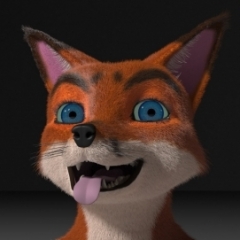Leaderboard
-
in all areas
- All areas
- Videos
- Video Comments
- Files
- File Comments
- File Reviews
- Pipelines Tools
- Pipeline Tool Comments
- Pipeline Tool Reviews
- Databases
- Database Comments
- Database Reviews
- Plugins
- Plugin Comments
- Plugin Reviews
- Images
- Image Comments
- Image Reviews
- Albums
- Album Comments
- Album Reviews
- Topics
- Posts
- Blog Entries
- Blog Comments
- Status Updates
- Status Replies
-
Custom Date
-
All time
May 3 2016 - April 20 2024
-
Year
April 20 2023 - April 20 2024
-
Month
March 20 2024 - April 20 2024
-
Week
April 13 2024 - April 20 2024
-
Today
April 20 2024
-
Custom Date
05/17/2022 - 05/17/2022
-
All time
Popular Content
Showing content with the highest reputation on 05/17/2022 in all areas
-
The Warped Dimension online festival was this weekend and I did a shot Q&A for my film. I also won best foreign film!5 points
-
Sure here it is: https://www.dropbox.com/s/91bkqkq49zmw49s/zen.zip?dl=0 I've done some modify on the previous file to get better results in the viewport, you will find also a basic "glitter" effect. Here is a quick video done using the viewport renderer: https://www.dropbox.com/s/6hruaseha7duppp/zen test3.mp4?dl=04 points
-
Hey everyone, I recently made my little sculpting tools plugin free. On the phone right now so check the links below to find out what it does and where to download. Supports R20 to S26. Note that this has absolutely nothing to do with Xpresso, but the forum forced me to add that tag otherwise I couldn’t post. @IgorSomething you could fix perhaps? This is a C++ plugin. https://www.plugins4d.com/Product/SculptProjectionBrush https://www.plugins4d.com/Product/SculptAnimator Cheers, Kent3 points
-
Wow, what a mistake to give it another try to communicate to you after the first encounter was just the worst experience. Either there is a language barrier (sorry not native English) or you are intentionally trying to read negatives into my responses. I honestly tried to understand why the rest length is so "crucial" and did instantly recognize that it's useful. And on the curly option. It honestly doesn't get easier than a checkbox and it comes with the same set of conditions as it does in vellum, that I tried to help you with, to get a good first experience with the feature. I don't think you are trying to help and your social media rants are borderline slander. You burned all bridges, good bye.3 points
-
You are reading way too much into these comments and are getting emotional about them instead of just taking them as they are. He is just being straight up, to the point. What’s wrong with that? Remember you are talking with people here for whom English is not their main language. Fritz doesn’t need to be here, he doesn’t need to comment about anything. He probably isn’t in charge of what gets developed. He is just trying to help because he knows about this topic and is providing information how to use it as well as asking for more info to clarify what you actually need. Then you go and attack him? This is not a MAXON forum. Nobody from MAXON even needs to be here. If they do respond it is on their own time to help. What if someone else replied to you the same as Fritz did? Would I now be rude?3 points
-
My film "Whistle and i will come" was select3d for 2 festivals. I had to hide the youtube post for a couple weeks so it can premier at the Warped Dimension festival on the 14th of May but it will be back online the 15th. Th ask to everyone here for encouraging me while I was making it! At the Warped Dimension film festival May 14, 2022 (Online Festival) https://www.ahith.com/mrholeheadwarpeddimension I will be doing a Q&A over Zoom the 14th so sign up! New York Istanbul Film Festival The event is May 6th but I don't know much more than my film is one of the selections! http://www.newyorkistanbulshortfilmfestival.com/About/ The film is off Youtube temporarily so it can premiere officially at the Warped Dimension festival!2 points
-
Okay, here is THE MAAAAATH. May contain trigonometry. Let's state the obvious first: This is a prototype / proof of concept, and horrendously simplified. Also, there is something that I initially called an issue, but meanwhile I am sure it's a problem with my thinking, because the math is fine and does what I expect. Look at the end of the TL;DR post to check. Python Waffle Deformer With Cone.mp4 In this scene, I have added a cone element to visualize what should happen; this cone is an add-on that you can delete! The actual algorithm keeps its "cone" virtual (that "cone" is also infinite!). There is a stage (obvious), there is an object to deform(Plane.1) that you should feast your eyes upon. Then there is a group InvisibleOriginals which contains the neutral base version of the object. I need to keep it somewhere because the algorithm is not in a Python deformer (which doesn't exist) but in a Python tag, and if I worked on the original it would lose the original point positions, obviously. This is all prototype garbage. The Python tag contains the actual algorithm. There are also UserData in here, where you can set the angle of the virtual cone, and the tilt of the cone axis (also controlling the cone diameter). The children under ConeRotational realize the graphic cone in the scene. The cone is still parametric so you can set the height or the subdivision, but the diameter and the tilt must be controlled by the Python tag's user data. There is an XPresso tag that automates all this. Note the limitations! The code works in the current object's coordinate system. The center will always be 0,0,0; the rest position of the cone will always be the z axis, and the code will only properly handle points in the positive x half (avoiding issues with ambiguous angles). Now, the algorithm. import c4d import math def main(): origObj = doc.SearchObject("Plane") obj = op.GetObject() pts = origObj.GetAllPoints() coneAngle = op[c4d.ID_USERDATA,1] coneTilt = op[c4d.ID_USERDATA,2] coneTan = math.tan(coneTilt) coneTanSqr = 1.0 + (coneTan*coneTan) zAxis = c4d.Vector(0.0, 0.0, 1.0) for index, p in enumerate(pts): if p.x < 0.0: continue pLength = p.GetLength() pAngle = c4d.utils.GetAngle(zAxis, p) if pAngle < coneAngle: pArcN = coneAngle - pAngle pArc = pArcN * pLength pNew = p * c4d.utils.MatrixRotY(-pArcN) wheelHeight = math.sqrt((pLength*pLength) / coneTanSqr) wheelRadius = coneTan * wheelHeight pRot = (pNew * c4d.utils.MatrixRotY(coneAngle) * c4d.utils.MatrixRotX(-coneTilt) * c4d.utils.MatrixRotZ(pArc / wheelRadius) * c4d.utils.MatrixRotX(coneTilt) * c4d.utils.MatrixRotY(-coneAngle) ) pts[index]=pRot obj.SetAllPoints(pts) obj.Message (c4d.MSG_UPDATE) In line 5, we look for the original object which contains the base positions for all points. These points will be transformed by the code and set into the current object which we get in line 6. (These two objects must initially be exact copies of each other because I don't test anything here, not even the point count, and I don't catch errors either, so be careful.) Then we get the points themselves, the two user data elements, and define a z axis vector; this is all trivial stuff. We also define coneTan and coneTanSqr because we need the tangens of the tilt angle later. In line 16 we loop over all the points, and in 17 we test for the positive x side (see above for limitations). All basic. Now, we have two major angles in the algorithm. The first is the angle between the cone and the z axis (current cone rotation around its tip in the XZ plane), which the user sets, so we know that already: coneAngle. The second is the angle between the current point (as a vector from 0,0,0) and the z axis. This is calculated here as pAngle (line 19). In line 20, we test whether pAngle is smaller than coneAngle, or in other words: Did the cone during its rotation already pass the point, so it will be transformed ("it sticks to the cone"), or has the point not yet been touched? The critical line is the one where the cone touches the XZ plane ("where the cone lies on the plane"). It would be equivalent to the z axis rotated by coneAngle, but we do not explicitly calculate that vector. -- We skip all untouched points, and look only at those which have been "rolled over" by the cone and now "stick to the cone", so pAngle < coneAngle. Now, where will our point be on the cone surface? First, we have a look at the arc that the point describes in the XZ plane when "dragged along" by the cone. Imagine each cross-section (perpendicular to the cone's axis) as a tilted wheel (tilted, because the cone axis is tilted; observe the physical cone's bottom as example) that rolls over the XZ plane and therefore over our waffle (the actual object). Each of these infinite little wheels describes a circle around 0,0,0 as its "trail" in the plane. (This is the line that Kweso painted on his cone waffle paper. Looks more like a parabola there, but obviously it must be a circle arc because the cone as such only moves circular.) You can imagine for each point of the waffle one such wheel-cross-section on the cone whose trail goes right through the point. Note that the radius of the trail is identical to the length of the point (as a vector from 0,0,0), but that length is not the cone's height up to the center of the "wheel" because of the tilt! It's a line on the outside of the cone, and therefore longer than the corresponding cone height. Okay, now imagine the following: The wheel rolls happily along its path, and then it rolls right over our point and "picks it up" so now the point is stuck to the wheel, and therefore to the cone's surface, and it will stay there and move with the cone. That way, our waffle is formed. -- Since the point has been passed some time ago (pAngle < coneAngle, remember), we just need to find out where this point is now, when the coneAngle has increased. We know that the point stays on the same position on the wheel that it got when it was "picked up", so we can describe the point position by a rotation - the rotation of the wheel around the cone axis. Just how large is that rotation? Let's look first at the part of the path arc that lies between our current point p (original position) and the position where the "wheel" touches the XZ plane with the given cone rotation coneAngle. Described by an angle, this is coneAngle - pAngle, or pArcN (line 21). How long is the arc as a distance? pArcN is given in radians, which is the length of the arc for this angle on the unity circle. So, we just need to multiply with the radius of our actual arc (pLength) to get the length of the larger arc (the dependency between the two arcs is linear). This is done in line 22, so pArc is how far the "wheel" has rolled since "picking up the point", as a unit of length. Or in other words, if we wind this length around the wheel (multiple times if necessary) starting at the current position where the wheel touches the "ground", then we will get the position where the point p is now. Yeah, I should have made an animation of that. Essentially, we will do just that: determine where the "wheel" touches the ground at the moment (with this coneAngle), and then find out where we get to when we wind pArc around the wheel. Next step towards that goal is to find the wheel's touch point. That is, we rotate p around Y by pArcN (in this case, -pArcN because of the rotational direction of the cone), which we do in line 23. Then, we just need to rotate p around the wheel for an absolute pArc. (Warning, if you have followed so far: The absolute pArc is not described by the angle pArcN, so it is not sufficient to rotate p by pArcN on the wheel. pArcN is a radians value, so it's only equivalent to a true length on the unit circle. On a circle with the radius pLength, it gives us the arc of the length pArc, because that is how we got pArc in the first place. Applied to a circle with the radius of the "Wheel", it gives us some other length, depending on the radius. So, we'd end up with the wrong position for p.) Sadly, we need more math at this point. We do not know the radius of the "wheel" yet, or the distance of the wheel's center to 0,0,0. But that's what we need to wind up pArc. Bummer. An idea to get these values is to have a look at the length-wise cross section of the cone up to the "wheel", which is a right-angle triangle. One side (let's call it a) is the vector between 0,0,0 and the wheel's center (incidental to the cone's vertical axis of course, and therefore tilted against the XZ plane by the angle coneTilt). One side (b) is the vector between 0,0,0 and the point where the wheel touches the XZ plane (this line runs along the surface of the cone, and lies in the XZ plane, incidental to the cone's "touch line"). The final side (c) is the radius of the wheel; this side is perpendicular to the first. Does that help? Indeed it does. The length of a is what we are looking for, name it as the great unknown x. The length of c is tan(coneTilt) * x (now I'm not going into trigonometry, have a look at some diagrams of the unit circle to learn about the tangens). The length of b is obviously pLength (or the secant of coneTilt multiplied with x, but we don't need that here). As a right-angled triangle, Pythagoras tells us that b² = a²+c² (b is the hypothenuse here, sorry for naming the sides that way, not going to rewrite it now), or pLength² = x² + (coneTan * x)² -- coneTan was defined back in line 12 --, and when we resolve for x, we get x = square root ( pLength² / (1+coneTan²)), which is how we define wheelHeight in line 25. coneTanSqr was also defined outside the for loop back in line 13. And at last, the wheel's radius coneRadius is coneTan * wheelHeight because that's what a tangent does. Good news, the math is almost over. We just need to rotate our relocated point (now pNew) on the wheel by pArc / wheelRadius -- pArc defines the absolute distance we want to travel on the wheel, and dividing by wheelRadius is needed to reduce the wheel to a unit circle so pArc can be interpreted as an angle in radians. The rest of the transformations in lines 29-33 is just because we rotate around an axis that is positioned arbitrarily in space (the wheel is tilted and the cone rotated). So, to create a proper rotation matrix, we must first turn the cone back to the z axis, then perform the desired rotation around z, then turn the cone back. You know the drill. Fortunately we have a common center and all the angles readily available. pRot as result of the transformation is written back to the point array, and at the end we put all the points into the object (yes, we got the points from the original object and now set them into the deformed object, this is why both need to be the same). Done, no more math! ----- Now the little issue which may not be an issue at all. If you look closely while turning the cone, you will notice that the waffle points do not stay still when transformed onto the cone surface. The cone itself seems to rotate slower than the bent waffle. Try it by setting the tilt to 45° and observe how the waffle's corner points move across the cone's grid. I would have expected that a point remains glued on the cone surface once the cone rolled over it. Python Waffle Deformer With Cone Movement Detail.mp4 On further thought though, the observable movement must be correct - because if the points were glued to the cone, the waffle would get massively distorted. (You can test that by introducing a factor on top of pArc / wheelRadius to slow down or accelerate the points on the cone.) So, I'm still thinking about the reason why this happens (must happen?) -- I have a feeling I am close to the solution. Duh, my brain needs a break. Python Math Test_Posting.c4d2 points
-
FYI: For anyone reading this thread and hasn't seen Thanulee's work, check out his Patreon here: https://t.co/kwDXCWS6Eh And the cool video on twitter here:2 points
-
Here is an example how to rebuild align to spline as a capsule. Generator has link slot to load a target spline and child object is aligned Available controls Nodes that make it work Result in viewport As one can see, just a handful of nodes can actually make nifty functionality. Feel free to expand on this setup! 20_Align_To_Spline_capsule.c4d2 points
-
I understand your concerns but regarding bug fixes there are few notions to keep in mind. First is, realistically how critical certain issue really is and is it really concerning vast majority of users? Second is the ability to fix an issue in stable manner and not cause issues elsewhere. Then there is also a potential of not being able to find a viable solution or maybe the feature is being replaced short term etc. There are multiple factors here. Cinema is huge and complex software and things are never simple as they may appear 🙂 Regarding beta forum, all I can say it is lively and I haven't witnessed anything of which you describe in past few years but have to admit I can't keep track of all the topics there Now, I know Fritz in person and I could hardly imagine him accusing you of anything and am sure he is genuinely interested in feedback, that is why he is on the forum. Must say that is quite rare to have a dev directly responding in public forum, and devs are shy beasts. Let's not scare them away!2 points
-
@thanulee Ever thought of applying for beta at Maxon? I must admit I fail to see why things turned a bit iffy in this topic, I presume there is some communication outside the forum which contributes to this...? I am not on social media 🙂 My suggestion would be for all of us to be constructive, everything else is just waste of everyone's time...2 points
-
Maybe I'm missing something, but it seem to be very simple to get similar results using a spline modifier and some basic geometry:2 points
-
No, I don't want to discourage you from posting - we constantly have threads featuring feedback, and yours are invariably helpful IME, but we just need to not do it couched in the seething anger that seems to surround it ! It is perfectly possible to express even deeply negative feedback without being in the slightest bit rude about it to the people who are engaging with you... CBR2 points
-
This is not the way to talk about anybody @thanulee !! I think Fritz is owed an apology. He has read your feedback, thanked you for it, asked you to elaborate, which you briefly did, and his latest response seems entirely reasonable to me. Why would you imagine he is pretending anything, and be so disproportionately hostile and rude about someone who is obviously trying to respond as helpfully as permissions allow ??! On a personal note - what incentive do you think this sort of thing offers developers to engage with the public if they are to face this unwarranted hurricane of piss when they do respond ?! Appalling behaviour ! CBR2 points
-
This is pure growth. We can't hire fast enough. We have already hired over 30 people this year. We have a brand new office space to fill 🙂 Cheers Dave2 points
-
Hi Thanulee, Thanks for the feedback. - For caching I suggest using alembic for the moment. - I don't disagree on rest length control, but could you explain how is it most crucial for cloth? - nearly every parameter can already be controlled by a map (unfold the parameters > ). Pressure is a volume constraint thus not controllable by a map. You can control the stretchiness of the surface instead if you want areas to stretch by internal pressure. - twist constraints in rope can be activated with the "curly" option. This constraint however quickly feels like it does nothing with many rope segment just having tiny error in the solve, so you either need very high iterations or just lower resolution lines (reduce spline subdivision). Regards Fritz2 points
-
Hi folks! Please find multiple open positions for all products in MAXON here. https://www.maxon.net/en/about-maxon/careers In case you feel that you have a set of skills that we could use, don't be shy in dropping me a pm Regards1 point
-
Heya, New dynamics system has great potential, once bugs get addressed and stability kicks in. I know developers lurk in this forum so I would like to add a list of features that I wanna see in next version that I feel are essential in order to art direct the new system: - A cache system that is robust and can write caches outside c4d (this is long time lacking). Houdini is a great example in that regard. - Field force support. - Rest length in cloth. The most crucial parameter to get detailed cloth and its missing for now. - Vertex map support in every parameter. These maps are essential in 3 places; bend/rest length and pressure. - Connection with cloner object/effectors. Eg. the ability to scale objects. - Follow position. - Constraints on rope that don't allow it to spin on it local axis. In Houdini this is an extra set of constraints found on hair instead of strings. Feel free to add anything that I cannot think of. I would expect some strong focus on this area for R27 as after fiddling with it a bit (and getting also the same feedback from a lot other people) the cloth is not production ready at the moment and its missing many things. Although is super fast, needs lots of love. Thanks!1 point
-
Gavin Shapiro has been making looping VJ videos featuring penguins and flamingos for quite some time. Official site His technical skills for creating never-ending zoom/scale self-similar geometries procedurally fascinated me the first time I saw them. Later he made a tutorial (and guest-starred on Rocket Lasso) explaining the methods he used. The following video is his latest creation. This is the first time I see a so well done 3D optical illusion. Feel free to geek-out on speculating how he could have made those penguins travel on the same path from two different viewing angles at the same time.1 point
-
That is awesome! You are now an award-winning animator! Very few can say that. Dave1 point
-
Thanks thanulee, I appreciate it. And yes a lot of the cheap plugins I put out were all alpha/beta, but they were marked as so. And was always happy to refund anyone who had problems with anything. Although it looks like you only bought the Alpha version of Quadriflow for $10 back in 2019, which did have limitations. I have worked with C4D for over 13 years now (even worked for Maxon for a large chunk of that) and all I can say is that Germans are direct, which I really liked. There was no messing around in a conversation, you got straight to the point. Even when ordering food from a deli in a supermarket in German, there are no "how can I help you today sir", "please" or "thank yous", just get to the point of what you want. Same goes for emails, so not just a English second language issue, but also a cultural issue. So any messages that come directly from anyone there (and it is amazing to see developers on this forum BTW) needs to be read without taking any emotion from it at all. It is not anyone being rude, dismissive or condescending. Please consider reaching out and joining the internal Beta forum at Maxon. Then you can get in on the action before it gets released. Your concerns posted here will have all been noted down. Fritz has most likely given you as direct an answer as he can, given NDA's and his inside knowledge of what can be actually done in a given timeframe. Creating features is hard work, and takes a very long time. You simply can't fix or add everything that a user suggests. This new cloth system only just got released. There are probably hundreds of other features and issues that are already being prioritized right now for the next version. Development is complex and trying to please everyone is hard to do.1 point
-
Hey, I spent the full day trying to figure out a discrepancy in my code (to no avail, actually; maybe it's really a rounding error but I am miffed), do I get a ribbon too?1 point
-
Auto, and a couple of Smooths... it took me 15 seconds 🙂 But it was all based on your paper image and post, so 99.99% credit goes your way1 point
-
Giving Iterate Collection a few more options is a good idea. Index Output is already on the list, if you have any further ideas you know where to put them 🙂1 point
-
Regarding Asset Editing. The current options are the neccesary minimum, we are working on improving that experiencer, but personally i do not want to rush it. One way to update assets is to convert the asset to a group, make and test all modifications, then copy the group, edit the asset and paste the group into the asset. Then rewire the input/outputs, ungroup the group and save the new asset version. For this to work you need to tkae a bit of care that the ports on the asset are not dependent on any nodes in the setup (propagated), otherwise they might change names or properties if you ungroup the inner group.1 point
-
Thanks! I meant, the number of points vary between the different fractal types and thus more complex fractal types are slower (Koch Snowflake and variations). And the setups never append points, they both work on one large array already containing all points needed for the last iteration. I had hoped, this is what my setup currently would do. One thing is for sure, the way I slapped together the different Koch versions is stupid. Very apparent for the Quadratic Island type... no discussion about that. I simply didn't care about that aspect. I'm far from a math guy. For the Dragon Curve, I'm not sure, it can work backwards. For the Koch types, I do agree, a bunch of calculations could probably be dragged out of the loops. And it could be implemented much more generically. Especially when having an idea (like adding in other types), I tend to copy/paste a lot, instead of taking a step back, rework and then add in on a more solid basis. Depending on personal or general interest, I may then later refactor. The Single Spline option is another example for this. The array preparation is a giant big mess. Nobody needs to look for different words to describe it. I'm not proposing at all, these are optimal solutions. And for sure the posted setups could be optimized further within their sub-optimal approach. I'm learning Scene Nodes on the go, probably just as everyone else. And for sure, when playing around with stuff like this, I tend to come up with my amateurish approaches by iterating on my own stupid ideas, instead of sitting down first, looking for good solutions others have come up with before (and for fractals mathematicians for sure have come up with optimal solutions for all of them). That's what sane people would do. I am not. Partly because for me that's where the fun is. Puzzling around and see, how far I can get on my own, without spoilers, how it is actually done. The sane approach I already have to use, when doing paid jobs. Luckily here it's not. For the moment, I'm more interested to look into different fractals. But if you prefer to thrive for a more optimized solution for maybe the Koch types, I'll be happily coming back to these later on. Please don't get me wrong, I appreciate your thoughts a lot. And I'm thankful for every idea about further optimizations. I may just not jump right away onto every one and try to implement. But I will try to return to Koch eventually. Also these setups can be considered public domain. Everybody is free to modify them. If after modification there is still some part of my work visible, I'd appreciate to be mentioned, but it is by no means mandatory.1 point
-
1 point
-
There are new offices in US and Germany. German one is one I have been too and it is really nice . Top floor, nice view, lots of space and Bad Homburg is nice place. As a bonus, really good coffee place nearby but that is just me 😛1 point
-
Iterate Collection has much better performance than Get Element, so the two parallel iterators should be preferred where possible.1 point
-
1 point
-
We do need it ideally, and the SDS shrinkage we get using those techniques is something that works against that precision. Particularly problematic when you want infinite resolution on a retopo'd cad mesh and all your snapping tools are based on the base mesh, not the SDS result, meaning things need manual inflation after the model has been established, which means re-projection targets no longer apply. It's not insurmountable, but it can be a PITA sometimes, and often means I have to build a base mesh at higher resolution than I would like to minimise that problem. CBR1 point
-
Concluding, yes I won't post again I ll direct talk to people in proper places as it makes more sense than arguing in forums with people that don't even like to hear feedback. FYI the reason my other colleagues do not post, is this exactly; they all feel pushed away and ignored and they don't wanna get frustrated. Or simply they are not nerds like me that sit after hours and try to solve work problems for everyone. This post represents the opinion/feedback of many artists I talked to last month about s26 new dynamics. And it's one thing debating in forums and another doing actual hands on work daily with demanding clients. Having to switch 10 tools cause your main 3d software cannot complete simple tasks like a cloth without collisions or caches that don't break is a bit dated in 2022. Cheers!1 point
-
Don't be disheartened ! Learning modelling to a high level may take years and years, but it's a very rewarding journey, and there is lots of help available... CBR1 point
-
For our first post here is a small helper generator which will show point indices of objects we put under the capsule (generator). Capsule has control for size and color of generated visuals in viewport Capsule is used as any other generator in Cinema Here is a graph view so one can replicate in older versions even though I would suggest using R25 Hopefully comments describe what is going on. Possible expansion of this setup would include orienting the resulting index according to given point or change size depending on camera distance (try it!) 160_Index_display_capsule.c4d1 point
-
1 point
-
Hi Fritz, Thanks for the reply. - I can live with alembic. - About rest length this is impossible in c4d: https://www.instagram.com/p/CcxyeHNMReB/ - Definitely missing the pressure vertexmap and animating stretch is not the same thing. In Houdini it simply happens and there must be a way in c4d. Rest parameters are not important imo. Rest length (when added) and pressure are the only ones needed. - Ok about ropes I guess its not gonna work proper and easy right? I guess field force and mograph connection are out of the question? Trying to see if it worths checking this system further or stay in Houdini for proper cloth/rope control. Thanks!1 point
-
Let's assume we have a plane (where the waffle lies). Then we have a cone, which is defined by a center/tip (let's use the center of the plane), a rest position (we can use the x axis), and an opening angle. The opening angle defines the tilt of the cone's center axis against the x axis. Also, the opening angle defines the tilt of the cone's circular cross section that we need to define the movement of a point. Now, we want to move a point of the waffle. The movement of the point is defined by the position it would have if it rolls on the cone's surface. (Let's stay with points in the plane for a moment.) How far does the point move? It moves on the tilted circle which is the cone's cross section. That means we can calculate the distance by getting the arc that the point "wanders" in the plane, which is its rotation around the center of the cone in the plane. Where does the point move? We just need to rotate it on the cross section circle about exactly that distance in the proper direction. Unfortunately, the rotational axis is none of the "natural" axes but this weird tilted rotated cone center axis. But hey, math. And actually that should do it. I may need to think about whether this works for points not on the plane, as well. ...don't we have a Python Deformer?1 point
-
To demonstrate Blender's curve options, check out the official demo file. All curves: (ps this is a screenshot of the viewport) https://www.blender.org/download/demo-files/1 point
-
Another way c4d users can steal some free goodies from the Blender bowl...is to leverage Blender's rich curve technology. While c4d users enjoy lots of options in manipulating splines, there are a few extra tricks that Blender enjoys. (To seize these treasures a bit of exploration and study of Blender is required.) For instance Blender can not only extrude a spline, but can manipulate the extrusion depth and extrusion tilt per vertex. And that extrusion can be beveled in a variety of ways. This image might explain a bit. Blender calls splines curves. The curves feature set makes the following possible, working only with a single curve and no additional tools or manipulations. If you want to bring in an EPS/Illustrator path save it as SVG and you can import it into Blender. So a power c4d user can bounce into Blender, quickly knock out something like this, and pull it back into c4d.1 point
-
1 point
-
And just got a reply from the support that they don't keep bug tickets open until resolved. All these are unacceptable, unprofessional and irrational. And that is reflected on Fritz's replies. That is my honest feedback, you can hate me as much as you want.0 points
-
I'd just like to express my sadness, that this had to turn into one of these threads again. Even more so, as it seems to have the inevitable outcome. May I assume, it was Thanulee's intention to hurt this community. It's hard to read some of these posts in any other way. Very unfortunate, a helping hand got burned. And it's not like we have an abundance of helping hands in here... 😞 May I ask, if anybody is still wondering, why Maxon people are so rarely getting into contact with the outer world?0 points
-
As you see unless I start public posting again nothing will happen. He pretends he doesn't understand why rest length is important and indirectly rejected everything else I said. And says that he gave us the solution in something which was in his own words semi broken But other than that, This is a total waste of my time as probably Maxon developers are super bored and rude.-5 points









